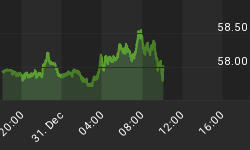This explains WHEN Institutional Investors are about to shift from Distribution to Accumulation ...
Question: Are Institutional Investors in Distribution now?
The answer is: Yes, but ...
Take a look at today's chart and you will see that Institutional Accumulation peaked in Mid-September and has been in a down trend since then. (Institutional Investors were in Distribution during most of October.) And with that, the market has lost steam and moved lower on the NYA Index.
But ... it matters what is happening to Institutional Selling activity while Distribution is going on. This important relationship can be see in Chart #2 below and it explains WHEN Institutional Investors are about to shift back to Accumulation.

Chart #2: So, why does it matter what is happening to Institutional Selling activity while Distribution is going on?
The reason is that Distribution is made up of two components: Institutional Buying and Institutional Selling. When Institutional Buying is decreasing with Institutional Selling increasing, then Distribution is legitimately increasing.
But, what would you say if Institutional Buying was increasing slowly, and the Institutional Selling was decreasing faster? If this continued, eventually there would be a point where the two trend lines would converge and a change of direction would be at hand. Distribution would shift to Accumulation mostly because of less Selling. (I would rather see Distribution shift to Accumulation mostly because of the Institutional Buying increasing faster and more abundantly.)
Think about it ... . after Institutional Investors have sold all the stocks that they want to sell, and take all the profits they want to take, they find less and less that they want to sell and you finally see a decrease in the amount of their selling. (After all, if they never stopped selling, eventually they would stop selling because they would have gone to cash.)
So, this suggests that the rate of Institutional Selling during times of Institutional Distribution is an important event to observe as an investor. (Which is why we follow it daily with posted charts on our other subscriber sites.)
And that brings up to Chart #2 where we show the trend of Institutional Selling and the trend of the Declining Volume on the New York Stock Exchange. Typically, there is a direct relationship between the two ... often out of phase, but still a direct correlation.
With that said, let's discuss Chart #2. Take a look at the April/May period on the chart. At label 1, you can see that the Inverted Institutional Selling chart, and the Inverted Declining Volume both went down with the NYA Index going down. BUT ... note what happened after that. The next lower dip on the NYA Index occurred with LESS Institutional Selling and LESS Declining Volume. That showed that selling was slowing down on the Institutional side and that they were about done. And that led to an upside reversal in June where the market rallied once again.
So now what is going on? It looks like there is now less Institutional Selling and less Declining Volume, and there is. However, the current conditions are NOT like the April/May event yet.
Why? Because of these differences:
1. The Inverted Institutional Selling trend and the Inverted Declining Volume have NOT stopped down trending yet. They DID stop with an upside reversal very early last June as seen by the blue arrows. So, this positive divergence differential will not kick in until after we get a trend change on these indicators.
2. If you look at Chart 1, you can see that the Distribution levels remained negative, but the Distribution also confirmed a positive divergence before the trend reversal. If you look at the current Distribution level, there is NO positive divergence appearing yet.
So, while the Inverted data is pointing to a reversal possibility that couldbe coming fairly soon, the net Distribution chart has not confirmed it yet andit is saying there is more work to be done. (There was also a non-confirmationlast Friday because the Inverted Institutional Selling and Inverted DecliningVolume have NOT shown any trend line cross-overs yet ... see the two blue arrowswith question marks to the far right on the chart.)
















